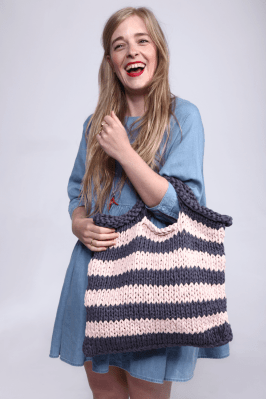The U.K.-based knitwear brand Wool and the Gang is hoping to shift fashion production away from factories by developing a global network of individual knitters. Although a knit sweater may be the ultimate in low tech, Wool and the Gang has raised a seed round of $2.8 million from Index Ventures, Wellington Partners, and MMC Ventures in order to build its online production network and capacity as an e-commerce company.
Since its founding in late 2008, Wool and the Gang has created designs in the U.K. and outsourced production to independent knitters in Peru. Kits including patterns and wool are also available for sale to go-getters who want to create their own Wool and the Gang clothing.
With this funding round Wool and the Gang is converting that latter pool of knitters into a network of producers for the e-commerce site. People can purchase materials from Wool and the Gang and sell the finished product back to the site, which will then mark it up to retail price.
The project, called the “Gang Collection,” will launch with 10 individuals and only a few designs, Wool and the Gang CEO Lisa Rodwell said. The plan is to start small in order to get the system right, but it can easily scale, she said. The number of Wool and the Gang consumers who buy knitting kits for their own use is already in the thousands.
“There are 55 million knitters in North America and Europe. As far as being able to scale, we don’t see that at all as one of [our] issues,” Rodwell said.
Could these knitters make Wool and the Gang a full-time job? Maybe. Most pieces should only take an hour or two to produce, so it could certainly be an easy source of cash for subway commuters.
There is of course the concern of brand dilution if production quality varies — something akin to a poorly stitched knockoff in comparison to the real thing — which is in part why the Gang Collection is starting small. Rodwell said that the core team will maintain relationships with the makers, using Skype to run sessions with them and giving tutorials when new designs are released. And every finished garment is shipped through the company’s warehouse, giving Wool and the Gang the final say on any piece.
And as Wool and the Gang ramps up these new production capabilities, it is building its brand. Like TOMS shoes, the ethos behind the goods defines the label. And like Etsy, which also carries knitwear, it appeals to those sensitive shoppers who like being able to turn a sweater inside out and see who made it and where.
Both in personality and production, Wool and the Gang might be considered a new approach to fast fashion. Because a pair of needles can move seamlessly from one design to the next, the medium is flexible enough that new designs can be added every other week. True, knitwear occupies a unique space and isn’t always competing directly with other brands, but that kind of fluidity benefits any label.
Moving forward, Rodwell said the company will focus more on e-commerce than it has in the past. Although Wool and the Gang used to sell more widely through offline retailers and will continue to sell more high-end, ready-to-wear pieces through them, online is a big opportunity. As production becomes increasingly global and makers evangelize to their local communities, it only makes sense that commerce also serves a worldwide audience.
Knitting is in a unique position to make this production system work because it requires so few components and only one pair of hands. Could it translate over into other kinds of garments? Unlikely. Unless 3D-printed fabrics get really good.
